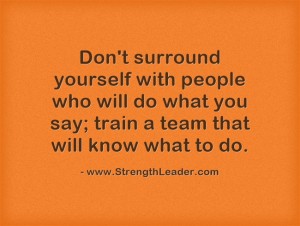
As a leader, one of your greatest responsibilities is to help your people reach their fullest potential.
It is not to surround yourself with people who will simply do what you say; it is to train a team that will know what to do.
How do you train your team members so that each is serving in and able to fully develop their strengths?
Map your team’s strengths.
First, assess individual strengths to be sure that each person is in the position that fits them best. If you have ever had to deal with an otherwise great employee who is cast in a role that just does not fit them, you know firsthand the loss of productivity and low morale that ensue. Next, map the strengths of your team so that each person brings their strengths to a table where their strengths can have true impact.
Encourage your team members.
For fast-paced, focused leaders, this does not come naturally. This is simply because you are focused on reaching goals and objectives, and having to deal with “people problems” only slows progress. One of the best ways to prevent “people problems” is to encourage your people. As important as it is to reach goals, it is MORE important for you as a leader to develop the people who will ultimately make those goals attainable. You may walk swiftly through the corridors, but spread encouraging words as you go.
Notice the good.
The fact is, employees dread the once-a-year review. It is often just a formality, a necessary evil, and, frankly, many leaders do not give it the true employee development focus it should be given. So while the annual performance review is required, do the optional: notice the good things your team members do throughout the year.
Take opportunities to teach.
Just as you should be making it a point to notice the good in your team’s work, you should also be quick to recognize and remediate issues. As a leader, you not only get the credit when your team does well, you must also address the challenges when they do not. Take these challenges as opportunities to teach your team members. This is the heart of mentoring. Address the problem and work together to develop a solution. This is how your team members learn and grow.
Organize training programs.
If you’ve been in business for any number of years, you know there is one constant: change. Be sure to provide your team with training opportunities for personal and professional development and for training as it pertains directly to their positions. If your team is failing to perform – here’s the tough part – it might not be the team who is at fault.
Recognize high achievers.
Leaders often look outside their organizations to fill a position. It is advisable to train your team in such a way that they will be ready to progress to the higher levels you have to fill. They bring to the position added knowledge – of the company, its systems, and its culture. These provide added value to the organization that an outside candidate may not possess. This goes back to knowing the strengths of your team members and knowing what is possible for them as they grow. In fact, a great leader will train a team member for a position long before the position becomes available.
Are you seeking to be a better leader? Seek to be a better MENTOR instead. Leadership will be the side effect.

Love it. I was just having a similar conversation with my accountability partner. We sometimes overdo the leadership focus and need to mentor more.